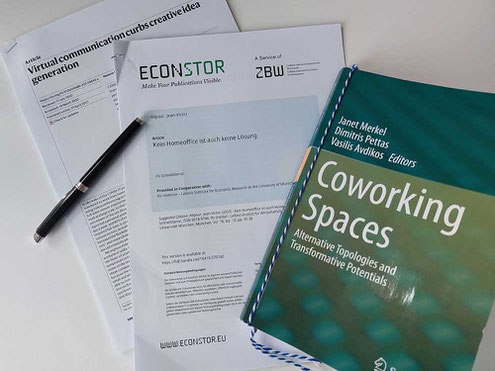
Hybrid working can lead to more innovation. This blog article explains how exactly the innovative power of hybrid working is strengthened. Nutrion has analysed current research and asked companies about their practices. Time spent in a coworking office proved to be a key factor.
Abstract
tl;dr: Working from home does not optimally guarantee the exchange of knowledge. In order to increase innovative strength, companies are therefore focussing on hybrid working methods. Spending part of the week in the office promotes creativity and innovation. This is where flexible coworking spaces come in.
Selection effect: efficiency at the expense of innovation?
Since the coronavirus pandemic in 2020, people have been arguing that working from home is more productive and efficient. Little attention is paid to who works more productively from home and whether this assessment applies to the entire company. Selection effects, a term used by researchers, capture the fact that it depends on which employees decide to work from home instead of their usual office. The work of younger employees often suffers, while experienced team members increase their output. This is because experienced employees do not have to worry about training and supporting others and are therefore less distracted. However, this can lead to a medium to long-term loss of expertise and innovative strength, as the younger talents experience less knowledge transfer and exchange of experience.
Digital communication can only support innovation to a limited extent.

In practice, the selection effect has been recognised and various companies are experimenting with solutions. Whether digital brainstorming, mentoring or virtual workouts, companies are trying to overcome the deficits of the home office in terms of communication, innovation and creativity. But not necessarily successfully. In practice, many people in our coworking spaces repeatedly emphasise that personal dialogue in the office as the key factor for one's own innovative strength. Even if working from home offers advantages, in-person work is increasingly planned and demanded. This is because digital communication restricts creativity. As a result, the power of innovation is only supported to a limited extent when working from home. “Where creativity and knowledge sharing are important, working from home can hinder informal or spontaneous exchange and thus long-term productivity gains” (Alipour, Ifo Schnelldienst, 2023; own translation). This is because virtual communication regularly leads to less creative team performance than when working together in person. This effect of virtual communication was already demonstrated experimentally during the coronavirus pandemic (Brucks and Levav, Nature, 2022).
More innovation with hybrid work
In order to achieve more innovation, the home office should be supplemented by face-to-face work in the office where the advantages of a spontaneous exchange of knowledge are available. Informal details, creative solutions and in-depth analyses can be carried out on an ad hoc basis as and when required. This exchange fosters creativity and innovation. The home office should therefore be combined with flexible coworking spaces to enable rotating days of attendance. In this way, innovative strength can be promoted in the medium and long term. An expanded pool of talent can be integrated into the coworking office. The advantages of a more diverse team of young and experienced employees can thus be optimally utilised as a practical transfer of expertise takes place.
Further blog articles and sources
Blog in German: Coworking ist ein relativ junges Phänomen. Trotzdem verdichtet sich die Forschung (Fraunhofer IAO). Es zeigt sich, dass die Innovationsfähigkeit von Unternehmen steigt, wenn sie Coworking Spaces nutzen. - Innovativ durch Coworking: Wie Coworking Spaces Innovation beflügeln
Paper in German „Wo Kreativität und Wissensteilung wichtig ist, kann Homeoffice den informellen oder spontanen Austausch und so langfristige Produktivitätsgewinne behindern“ - Alipour, Jean-Victor (2023): Kein Homeoffice ist auch keine Lösung, Ifo Schnelldienst, München, Vol.76, Iss.10, pp. 35-38; zuletzt abgerufen am 26.05.2025 unter: https://www.ifo.de/publikationen/2023/aufsatz-zeitschrift/kein-homeoffice-ist-auch-keine-loesung
“Our results suggest that there is a unique cognitive advantage to in-person collaboration, which could inform the design of remote work policies.” - Bruck, M.S. und J. Levav (2022), „Virtual Communication Crubs Creative Idee Generation“ Nature 605, pp.108-112; zuletzt abgerufen am 26.05.2025 unter: https://www.nature.com/articles/s41586-022-04643-y

